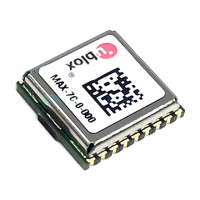MAX-7 / NEO-7 - Hardware Integration Manual
UBX-13003704 - R09 Production Information Design
Page 27 of 52
Active antenna supervisor is not configured and deactivated.
Active antenna connected and powered
Antenna not connected or antenna defective
Table 7: Active antenna supervisor message on startup (NMEA protocol)
3.4.3.2 Module design with active antenna, short circuit protection / detection (MAX-7W)
If a suitably dimensioned series resistor R_BIAS is placed in front of pin V_ANT, a short circuit can be detected in
the antenna supply. This is detected inside the u-blox 7 module and the antenna supply voltage will be
immediately shut down. After which, periodic attempts to re-establish antenna power are made by default.
An internal switch (under control of the receiver) can turn off the supply to the external antenna whenever it is
not needed. This feature helps to reduce power consumption in power save mode.
To configure the antenna supervisor use the UBX-CFG-ANT message. For further information see the
u-blox 7 Receiver Description Including Protocol Specification [4].
Short circuits on the antenna input without limitation (R_BIAS) of the current can result in
permanent damage to the receiver! Therefore, it is mandatory to implement an R_BIAS in all
risk applications, such as situations where the antenna can be disconnected by the end-user or
that have long antenna cables.
If the VCC_RF voltage does not match the antenna supply voltage, use a filtered external supply as shown
in Figure 23.
Supply from VCC_RF (MAX-7W)
Figure 22 shows an active antenna supplied from the u-blox 7 module.
The VCC_RF pin can be connected with V_ANT to supply the antenna. Note that the voltage specification of the
antenna has to match the actual supply voltage of the u-blox module (e.g. 3.0 V), see Figure 22.
Figure 22: Module design with active antenna, internal supply from VCC_RF
External supply (MAX-7W)
Figure 23 shows an externally powered active antenna design.
Since the external bias voltage is fed into the most sensitive part of the receiver (i.e. the RF input), this supply
should be free of noise. Usually, low frequency analog noise is less critical than digital noise of spurious
frequencies with harmonics up to the GPS/QZSS band of 1.575 GHz and GLONASS band of 1.602 GHz.
Therefore, it is not recommended to use digital supply nets to feed the V_ANT pin.

